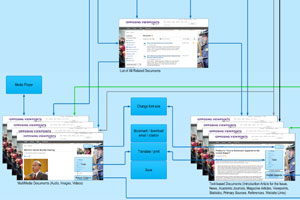System & Usability Evaluation of Gale Cengage Opposing Viewpoints In Context (OVIC)
As the lead for a number of milestones, I conducted contextual inquiries, heuristic evaluation, surveys and in-person usability test and proposed a set of 4 major recommendations (including 80+ minor ones) for Gale Cengage OVIC, an online journal finder designed for K-12 students.
Milestone 1: Interaction Map
Download Full-Size Interaction Map (4.5MB, PDF format)I individually made the interaction map using Microsoft Visio. The map visually illustrated all the possible actions, and “states” that those actions can lead to (how and where the user goes).
The interaction map offers a thorough understanding of the system's scope and variation in a systematic approach. Generating this representation was an important step to effectively evaluate the product in that it help predict where usage problems will occur.
Milestone 2: Interviews, Personas and Scenarios
Developing a detailed understanding of target users enables UX researchers to focus on their needs instead of relying on their personal opinion.
After a stakeholder interview with our client, we interviewed 5 people from K12 and community college libraries, which fit our target population. Based on that, we constructed three different fictitious characters (personas) that represent some of the dimensions of the people we interviewed. I wrote corresponding scenarios for each of the personas that greatly helped us maintain focus and scope.
Milestone 3: Comparative Evaluation
I lead my team in identifying a Comparison Matrix which covers about 20 competitors, including direct, indirect, partial and analogous systems. We compared OVIC with those competitors in terms of a set of parameters, namely functionality, usability, aesthetics, and intended users.
We gained insight into how competitors, for instance, EBSCO Points of View Resource Center and ProQuest SIRS Issues Researcher are achieving the same goals, what OVIC is good at and where OVIC falls behind. It also set the stage for more detailed evaluations later on.
Milestone 4: Heuristic Evaluation
Download Heuristic Evaluation Report (2.0MB, PDF format)I as the project manager led my team in performing heuristic evaluation. Based on Jakob Nielsen's ten heuristics we generated a heuristic table, which includes problems, reproduce instructions, recommendations, heuristics, screenshots and severity. Next, each team member completed an independent heuristic evaluation of the product. We then aggregated and prioritized the individual findings. As a result, we identified 8 severe usability issues and a total of 82 (I contributed 30 of it) usability issues and corresponding recommendations in the report.
Milestone 5: Survey
We surveyed 109 users to know how useful and usable of the content and interface of OVIC and other similar services. I proposed 10 of 20 questions and categorized them into groups, put them into Qualtrics, fully utilizing its advanced features, and used R to do the statistical analysis. I compiled the main part of the report.
Milestone 6: Usability Test
Download Usability Test Presentation (3.8MB, PPT format)I performed several in-person formal usability tests of the OVIC system to gather valuable quantitative and qualitative data on how actual users interact with and perceive the system. I, with my teammates, also designed privacy statement, user tasks, scripts, logging sheet, pre- and post- test questionnaire. We identified 6 major findings.
Final Recommendations and Results
Download Final Client Presentation (6.9MB, PPT format)My team and I presented Gale Cengage our findings and recommendations, organized into 4 majors areas of improvement: Searching, Navigation Experience, Maps and Resources and Content Browsing. Our presentation received positive feedback from the client and some of them are already implemented in the current iteration.
- One-Click TimeTracker UX Design & Development
- ShakeShare Product Design, UX Design & Development
- ChiltonPRO Tablet Interaction Design, Wireframing, Prototyping & Mobile App Design
- Who's That? Ubiquitous System User Research, Interaction Design, Wireframing & Prototyping
- OVIC Usability Evaluation User Research & Usability Evaluation
- Firework: Interactive Data Explorer Data Analysis, Prototyping & Information Visualization
- SocialCusp Wireframing, Prototyping, Interaction Design & Development
- PlainMed Mobile App Mobile App Design & Development
- SleepHabit Monitor Information Visualization
- Graphic Design Collection Graphic Design
- Homeshine Boutique Online Shop Project Management, Web Design & Graphic Design
- HBHE Genetics Research Website Information Architecture, Web Design & Development
- Gale Cengage Learning Contextual Inquiry Contextual Inquiry & Project Management
- UMBS Website Information Architecture, Web Design & Development

